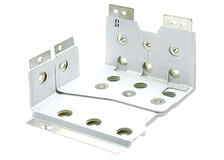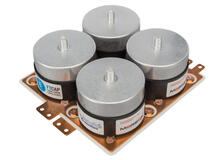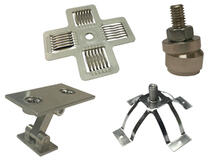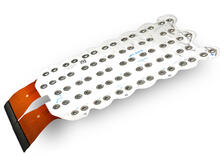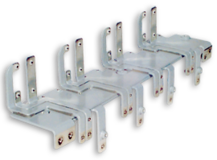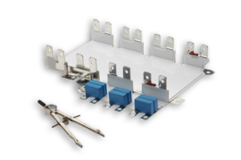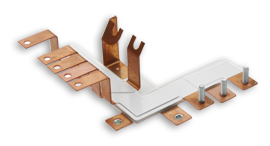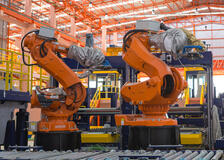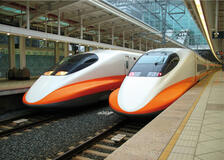
Bus Bar Technologies
Benefits
With over sixty years of experience in designing custom laminated bus bars, coupled with our global manufacturing and R&D footprint, Mersen has the flexibility and expertise to respond to our customers' requirements.
Our many years of industry experience include millions of man hours working to continuously perfect our products and processes. We continue to strive to develop and deliver innovative power solutions for a variety of applications.
Mersen has extensive experience in:
- Quality Control and Quality Assurance
- Engineering and Design
- Simulation and Prototyping
- Tool and Die Design and Build
- Assembly
- Epoxy Encapsulation
- Metal Fabrication
- Metal Joining
- Die Cutting
- Laminating
- Electrostatic Powder Coating
Capabilities

Superior Quality From Design Through Manufacture
From the first design consultation through dock to stock shipments, Mersen provides customers with innovative power distribution solutions. You’re always assured that we’ve omitted nothing in our quest for customer satisfaction. Let us offer you the same peace of mind that thousands of other customers have enjoyed for more than 60 years. Here are just a few reasons:
State-of-the-Art Metal Fabrication
Metal Fabrication capability is a key component to producing quality product. Our state-of-the-art metal fabrication is maintained in-house and includes CNC fabricators, production punch presses ranging up to 75 tons, CNC press brakes, and various edge conditioning processes. We also offer a wide range of metal joining processes, including induction brazing, torch brazing, and soldering.
Plating Finishes
Mersen can provide almost any finish to meet your needs. Our finishing includes tin, tin-lead, nickel, copper, silver and gold. Plating under tight, laboratory-controlled conditions, we monitor and control plating thickness to required specifications. Careful data monitoring, in-process controls, and x-ray testing combine to ensure a quality finish.
Precision Manufacturing of Dielectric Components
Precision manufacturing of dielectric components is crucial in laminated bus bar production. To ensure quality, we maintain calibrated humidity and temperature-controlled conditions to store our insulation. Precision steel rule dies are used for cutting the insulation, ensuring uniformity of size to produce quality bus bars.
Properly Selected Insulation
Properly selected insulation is the key factor to a bus bar’s electrical integrity. We utilize a wide variety of dielectric materials, including Nomex, Mylar, Kapton, Epoxy-Glass, GPO, Gatex and Phenolics readily available to virtually meet any specifications. In addition to traditional sheet lamination systems, we maintain our own electrostatic powder coating department that produces a quality epoxy finish with high dielectric protection for bus bars with geometric forms, or those used in harsh environments.
Assembly and Lamination
The assembly and lamination of bus bars are controlled using sophisticated laminating systems specifically designed and manufactured for each bus bar. Hardware and interconnection devices can be added before or after the laminating and plating process.
Show lessDesign Guide
What Is a Laminated Bus bar?
A laminated bus bar is an engineered component consisting of layers of fabricated copper separated by thin dielectric materials, laminated into a unified structure. Sizes and applications range from surface-mounted bus bars the size of a fingertip to multilayer bus bars that exceed 20 feet in length. Laminated bus bar solutions are routinely used for low volumes up through tens of thousands per week.
Unique Features in Mechanical Design
The physical structure of bus bars offers unique features in mechanical design. For example, complete power distribution subsystems can also act as structural members of a total system. The proper design of bus bars depends on an application’s mechanical and electrical requirements. This section includes basic formulas and data to aid design engineers in specifying bus bars for power distribution systems. Once an outline of a bus bar has been established, specific design and manufacturing considerations will affect the cost.
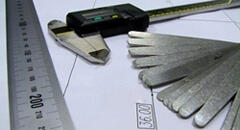
Engineering Toolbox
We’ve provided basic design criteria to help you specify bus bars for your application. The information required to specify a bus bar includes: conductor material, number of conductors (including ground), dimensions (length, width and thickness), interconnection schemes, mounting configuration (if required), type of finish and choice of insulation material.
Markets
Video
Custom Engineered Laminated Bus Bar Solutions
Find out more about Mersen's custom engineered laminated bus bar solutions in this Mersen Minute.


